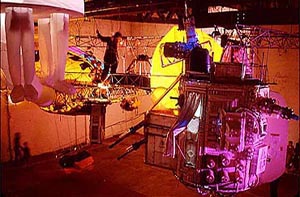About Wave Farm
Mir 2
Oct 18, 2001 - Nov 18, 2001
Smack Mellon Studios
A collaborative and multimedia installation based on the voyage from an international space station (Mir2) to a colony on the outskirts of Long Island. Included Jesse Bercowetz, Matt Bua, Carrie Dashow, free103point9, Stuart Sachs, Daniel Seiple, Ward Shelley and many others.
"Mir2 is an inhabited sculpture with 20+ channels of video and a large assembly of units hanging overhead in the formidable airspace of Smack Mellon Gallery in Dumbo. All the parts are made by different artists and combinations thereof.
One salient point to make is that nearly nothing in the Mir2 project is a discreet artwork. All works suffered the intervention of others in an attempt to arrive at a result all of us could endorse, though it would be going too far to say that always worked. It would also be going too far to say that as a group, we agreed upon what we were trying to do, or what the Mir2 project meant. In fact, this letter has a number of contributors and presents more than one view.
The working process was pretty much anarchy, a study in micro politics. Every decision was a conflict among 20 artists: there was no authority other than that which could be temporarily claimed on the basis of the best plan, the most allies, or the most insistent voice. Stubbornness counted for as much as diplomacy, but hopefully, inspiration carried the most weight. There was no democratic structure, only a shifting balance between the committed ego and respect for others.
Mir2 consists of a working space station complete with inhabitable units each specializing in specific tasks. Each artist invented a narrative context for their unit. The individual units and narratives are combined to create a collaborative hybrid space station.
Components of the physical space station include: mechanical end arm effector, sleeping quarters, cargo storage, dining room, floating bridge, human radiation rotisserie, pirate / parasitic laboratory, satellites, observation dome, intra-station tract vehicle, luxury lounge, and weapons system.
One theme running through the project is communication difficulty, which is first presented in pre-recorded videos in the front room and grows naturally out of the awkward physical space occupied by Mir2 and the complexity and fallibility of its systems.
Individual units are equipped with a variety of devices allowing direct communication between cosmonauts and home base: computers, two way radios, citizen band radios, low power fm transmitters, and closed circuit video surveillance video cameras.
Home base is in the video room with 30 TV sets. Half of those are connected to the live cameras in Mir2, others are playing pre-recorded material, and others play only static. Home base functions as a central dispatch for cosmonauts to direct dialogue from unit to unit via command central, often resulting in miscommunication, frustration and air rage." - Jesse Bercowetz & Matt Bua
One salient point to make is that nearly nothing in the Mir2 project is a discreet artwork. All works suffered the intervention of others in an attempt to arrive at a result all of us could endorse, though it would be going too far to say that always worked. It would also be going too far to say that as a group, we agreed upon what we were trying to do, or what the Mir2 project meant. In fact, this letter has a number of contributors and presents more than one view.
The working process was pretty much anarchy, a study in micro politics. Every decision was a conflict among 20 artists: there was no authority other than that which could be temporarily claimed on the basis of the best plan, the most allies, or the most insistent voice. Stubbornness counted for as much as diplomacy, but hopefully, inspiration carried the most weight. There was no democratic structure, only a shifting balance between the committed ego and respect for others.
Mir2 consists of a working space station complete with inhabitable units each specializing in specific tasks. Each artist invented a narrative context for their unit. The individual units and narratives are combined to create a collaborative hybrid space station.
Components of the physical space station include: mechanical end arm effector, sleeping quarters, cargo storage, dining room, floating bridge, human radiation rotisserie, pirate / parasitic laboratory, satellites, observation dome, intra-station tract vehicle, luxury lounge, and weapons system.
One theme running through the project is communication difficulty, which is first presented in pre-recorded videos in the front room and grows naturally out of the awkward physical space occupied by Mir2 and the complexity and fallibility of its systems.
Individual units are equipped with a variety of devices allowing direct communication between cosmonauts and home base: computers, two way radios, citizen band radios, low power fm transmitters, and closed circuit video surveillance video cameras.
Home base is in the video room with 30 TV sets. Half of those are connected to the live cameras in Mir2, others are playing pre-recorded material, and others play only static. Home base functions as a central dispatch for cosmonauts to direct dialogue from unit to unit via command central, often resulting in miscommunication, frustration and air rage." - Jesse Bercowetz & Matt Bua



